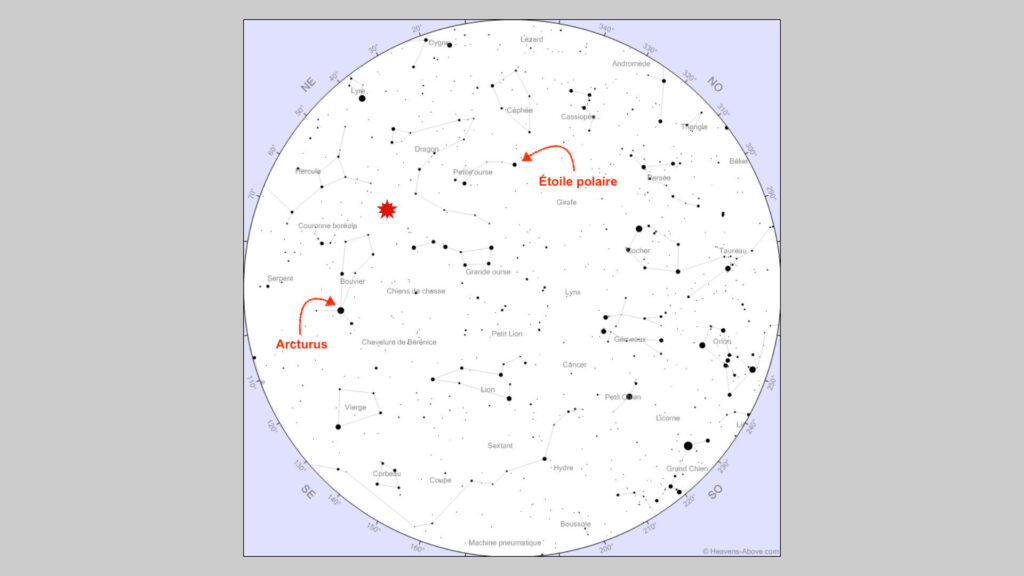The night of Wednesday January 3 to Thursday January 4, 2024 looks promising for observing the Quadrantids. Here’s how to try to see these meteors and where they come from.
There have been some great discoveries in space in 2023, thanks to the James Webb Space Telescope. But we can also look up towards the celestial vault. If you like astronomical observations, the year 2024 starts very well with a swarm of shooting stars that always returns during this period: the Quadrantids.
When exactly can you see the Quadrantids in 2024? What is the origin of this shower of shooting stars? Here’s everything you need to know to take advantage of it.
How to observe the Quadrantids?
Maximum activity of the Quadrantid swarm is announced during the night of Wednesday 3 to Thursday 4 January 2024.
If you attempt observation, know that your eyes are enough (in addition to a good winter coat). Of course, the weather must be good from your observation point in order to fully enjoy the spectacle. According to Vigie-Ciel, the observation conditions are not ideal tonight… but already better than last year. The swarm of shooting stars should be particularly observable at the end of the night.
More than a hundred shooting stars are visible during peak Quadrantid activity, in theory. In fact, it is always advisable to observe them at the end of the night, before dawn. Meteors will be few in number at the start of the night (less than 5 per hour). From 3-4 a.m.we should identify more, 20 to 30 visible per hour.
“ This is due to the fact that the radiant [ndlr : zone de la sphère céleste d’où les météores d’un même essaim semblent provenir]located in a constellation that has now disappeared, that of the Mural Quadrant […], is very low in the sky in the first half of the night, and only rises from midnight. However, the lower the radiant, the fewer the Quadrantids! », summarized Vigie-Ciel in 2021. The radiant of the swarm is to be found towards the east, above the horizon. It is located halfway between two very bright stars, Arcturus (Bovier constellation) and the Polar Star (Little Dipper).

The radiant serves as a guide for observing the swarm, but Quadrantids can appear anywhere in the sky — so don’t just stare at the radiant. It is also recommended to be patient: you must first let your eyes get used to the darkness for around 30 minutes.
The apparent speed of the Quadrantids is average. The meteoroids (particles moving in space) which cause it enter the Earth’s atmosphere at a speed of 41 kilometers per second (more than 147,000 km/h).
Where do the Quadrantids come from?
Every year, the Earth encounters dust trails in its orbit left by comets or asteroids in their own orbits. These small particles, upon entering the Earth’s atmosphere at high speed, produce furtive light phenomena: meteors (or shooting stars). Less famous than the Perseids (August) or the Geminids (December), the Quadrantids nevertheless have similar activity – but are more difficult to observe.
The origin of the Quadrantids is attributed to an object called 2003 EH1, an asteroid which could be an extinct comet (having lost its volatile elements). It takes more than 5 years for 2003 EH1 to go around the Sun. It is a small asteroid, with a diameter estimated at around 3 kilometers. According to Vigie-Ciel, 2003 EH1 ejected rock particles when it was still active, as it approached the Sun: these are the particles which continue to travel and which our planet regularly encounters.


The swarm’s peak occurs during the night of January 3 to 4, but its activity lasts longer, generally between December 28 and January 12. The peak is very brief (a few hours, instead of 2 days for other swarms), because the flow of particles crossed by the Earth is thin. In addition, the Earth crosses this flow at a perpendicular angle, explains NASA.
Now you know how to profit from the swarm in 2024, and where it comes from. All that remains is to cross your fingers that the weather will be favorable for observation! And don’t forget to make a wish.
Subscribe for free to Artificielles, our newsletter on AI, designed by AIs, verified by Numerama!
